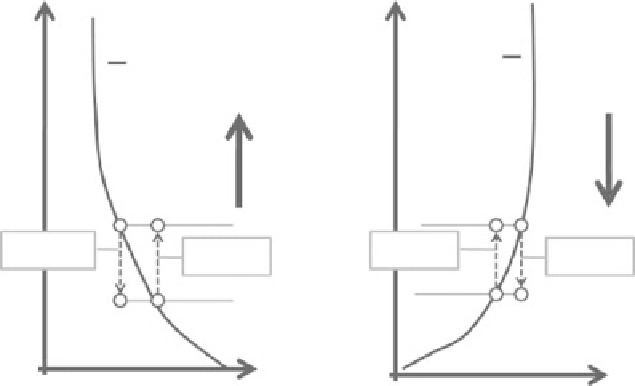Geoscience Reference
In-Depth Information
(a)
(b)
Z
Z
Net
upward
heat flux
Net
downward
heat flux
q
q
Figure 15.8
The correlation
between positive and negative
fluctuations in vertical wind
speed, and higher and lower
temperature fluctuations in
(a) daytime conditions with a
superadiabatic temperature
profile, and (b) nighttime
conditions with a stable
inversion in temperature.
Level 1
Level 1
w
negative
q
negative
w
positive
q
negative
w
negative
q
positive
w
positive
q
positive
Level 2
Level 2
0
0
0
q
0
q
Case (a)
Case (b)
The second term in Equation (15.23) also has dimensions of kinematic sensible
heat flux (compare Equation (7.8) ) and is called the
Turbulent Flux
or
Eddy Flux
,
in this case of thermal energy. It describes the vertical transfer that results if there
is a positive Linear Correlation Coefficient,
r
q
v
,
w
, between virtual potential
temperature and vertical wind speed. As Fig 15.7 shows, such correlation is quite
common. In fact the turbulent flux usually dominates the advective flux of sensible
heat in the vertical direction because mass conservation requires that the time-
average of mean vertical wind speed is small over flat surfaces. In the Y direction
the mean wind speed is zero by definition, so again transfer along this axis can
only be as turbulent flux. However, in the case of air blowing horizontally over
heterogeneous surfaces (e.g., patches of irrigated crop growing in an arid
landscape) where the near-surface temperature can differ from one location to the
next, transfers along the X axis, via the advective sensible heat flux term, may be
considerable.
Turbulent fluxes occur because turbulence is not truly random. If it were
random, positive excursions in the product of two atmospheric variables would be
cancelled out by negative excursions at some other time during the averaging
period. To further illustrate how such fluxes can arise, consider the example shown
in Fig. 15.8 which is for vertical sensible heat flux in (a) daytime conditions when
there is a superadiabatic temperature profile above the ground; and (b) nighttime
conditions when there is a stable inversion in temperature.
In case (a), a turbulent eddy giving a positive excursion of vertical wind speed
moves a parcel of air upward which is subsequently warmer than its surroundings.
In this case a sensor mounted between the levels labeled 1 and 2 would
simultaneously measure a positive fluctuation in vertical wind speed and a positive
fluctuation in temperature, so the product (
q
v
w
) would be positive. Conversely, a







